Ocean Energy Training Systems & Lab Equipment
Sort by
What are Ocean Energy Training Systems?
Ocean energy training systems are educational tools and platforms designed to teach the principles and applications of ocean energy technologies. Ocean energy, also known as marine energy, harnesses the power of ocean waves, tides, currents, and thermal gradients to generate electricity.
Training systems in this field allow students, engineers, and researchers to gain hands-on experience with the various technologies used to capture and convert ocean energy, including wave energy converters, tidal turbines, and ocean thermal energy conversion (OTEC) systems. These tools are essential for developing the skills and knowledge needed to work in the emerging ocean energy sector, which is a key component of the global push towards renewable energy.
What Type of Ocean Energy Training Systems Exist?
There are several types of ocean energy training systems, each focusing on different aspects of marine energy production and technology:
Wave Energy Conversion (WEC) Systems:
Wave Tank Simulation Models: These are scaled-down wave tanks that simulate ocean conditions, allowing students to test and analyze the performance of various wave energy converter (WEC) designs. These models help in understanding the principles of energy capture from wave motion.
Point Absorber Buoy Trainers: These training systems simulate point absorber buoys, which are devices that move with the waves to generate electricity. They teach students how these systems work and how to optimize their design for different ocean conditions.
Tidal Energy Systems:
Tidal Turbine Models: These are scaled models of tidal stream turbines, which generate electricity by harnessing the kinetic energy of tidal currents. They are used to study the effects of water flow on turbine efficiency and to understand the mechanical and electrical components involved.
Tidal Barrage Simulation Kits: These kits simulate tidal barrage systems, which capture energy from the rise and fall of tides in coastal areas. They help students learn about the construction, operation, and environmental impact of tidal barrages.
Ocean Thermal Energy Conversion (OTEC) Systems:
OTEC Demonstration Units: These are small-scale models of OTEC systems, which generate electricity by exploiting the temperature difference between warm surface water and cold deep water. They allow students to explore the principles of thermodynamics and heat exchange in ocean environments.
Heat Exchanger Training Modules: These modules focus on the design and operation of heat exchangers used in OTEC systems. They teach the importance of efficient thermal energy transfer and the challenges of operating in marine environments.
Environmental Impact and Monitoring Tools:
Marine Ecosystem Simulation Kits: These tools simulate the impact of ocean energy systems on marine ecosystems, teaching students how to assess and mitigate environmental effects. This is crucial for sustainable development of marine energy resources.
Water Quality and Marine Life Monitoring Systems: These systems allow for the monitoring of water quality and marine life around ocean energy installations, providing hands-on experience in environmental stewardship.
Control and Grid Integration Systems:
Energy Management and Grid Simulation Tools: These tools simulate the integration of ocean energy systems with the electrical grid, focusing on load management, energy storage, and the challenges of variable energy production in marine environments.
SCADA (Supervisory Control and Data Acquisition) Systems: SCADA training systems are used to teach the remote monitoring and control of ocean energy installations, including real-time data collection, system performance analysis, and fault detection.
Why Use Ocean Energy Training Systems?
Ocean energy training systems are essential for several reasons:
-
Skill Development: These systems provide practical, hands-on experience, which is crucial for developing the technical skills needed to design, operate, and maintain ocean energy systems.
-
Understanding Complex Marine Environments: Ocean energy systems operate in harsh and dynamic marine environments. Training equipment helps students and professionals understand these conditions and the engineering challenges associated with them.
-
Industry Readiness: The ocean energy sector is emerging and requires a workforce skilled in specialized technologies. Training systems prepare students and professionals for careers in this field, enhancing their employability and readiness to contribute effectively to the industry.
-
Innovation and Research: These systems offer platforms for testing new technologies and exploring innovative solutions in ocean energy. This fosters research and development, leading to more efficient and sustainable marine energy systems.
-
Sustainability and Environmental Awareness: Ocean energy is a key part of the renewable energy mix, offering sustainable alternatives to fossil fuels. Training systems promote understanding of the environmental benefits and challenges associated with ocean energy.
Best Practices for Using Ocean Energy Training Systems
To maximize the benefits of ocean energy training systems, it's important to follow these best practices:
-
Comprehensive Curriculum Integration: Ensure that ocean energy training systems are integrated into a curriculum that covers both theoretical and practical aspects of marine energy. This ensures a well-rounded education that prepares students for real-world applications.
-
Safety Training: Marine environments and high-energy systems can be hazardous. Proper safety training is essential to prevent accidents and ensure that students and technicians can work safely with ocean energy equipment.
-
Hands-On Learning: Encourage extensive hands-on practice with the equipment. Real-world application is key to understanding the complexities of ocean energy systems, from mechanical operations to environmental impact assessment.
-
Regular Maintenance and Calibration: Keep training equipment well-maintained and calibrated to ensure accurate results and reliable operation. This also extends the lifespan of the equipment and enhances the learning experience.
-
Scenario-Based Training: Use real-world scenarios, such as varying ocean conditions or changes in energy demand, to teach problem-solving skills and adaptability. This prepares learners for the challenges of operating in dynamic marine environments.
-
Environmental and Economic Analysis: Encourage students to analyze both the environmental impacts and economic viability of ocean energy projects. This holistic approach helps them understand the broader implications of marine energy development.
-
Collaboration with Industry: Partner with industry stakeholders to ensure that training is aligned with current technological advancements and market needs. This also provides opportunities for internships, job placements, and collaborative research.
-
Continuous Learning and Adaptation: Stay updated with the latest advancements in ocean energy technology and integrate new developments into the training program. This ensures that learners are prepared for the evolving challenges and opportunities in the ocean energy sector.
By adhering to these best practices, institutions and organizations can effectively use ocean energy training systems to educate and prepare the next generation of engineers, researchers, and technicians for the growing field of marine energy.








